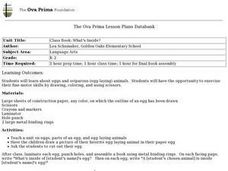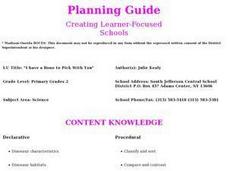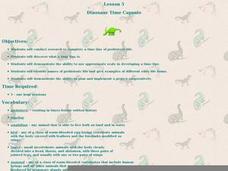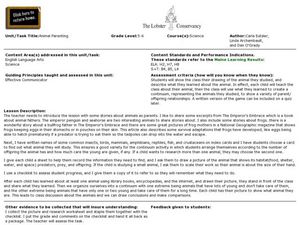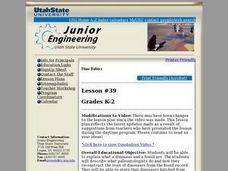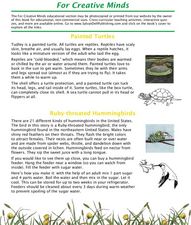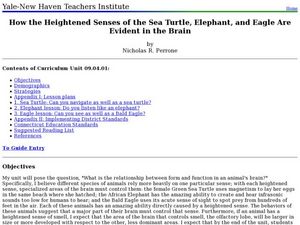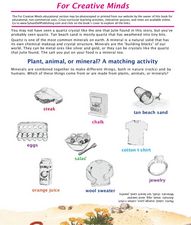Curated OER
Where Are the Dinosaurs?
Young scholars explore what the dinosaurs were like. In this dinosaur lesson, the teacher peaks student curiosity about dinosaurs. This lesson would be a great starting point for a dinosaur unit since it primarily engages student...
Curated OER
Baa, Ram, Ewe.... Sheep Tales
Students explore animal characteristics by reading animal stories in class. In this sheep habitat instructional activity, students identify the uses for sheep in our agricultural based society and the importance of wool in our economy....
Curated OER
Class Book: What's Inside?
Pupils make discoveries about eggs and oviparous (egg-laying) animals. Students will have the opportunity to exercise their fine-motor skills by drawing, coloring, and using scissors.
Curated OER
Life Cycles
Fourth graders explore life cycles. They examine pictures of the various stages of life cycles and put them in the correct order. Students match pictures of eggs to the correct parents. They discuss the importance of knowing the life...
Curated OER
"I have a Bone to Pick With You"
Second graders explore dinosaur classifications and how animals of long ago became extinct. They conduct research, classify dinosaurs, and in small groups, develop a name of a new dinosaur, create a poster, and present the information to...
Curated OER
Dinosaur Time Capsule
Third graders research prehistoric life using educational software. They design a prehistoric life while showing the use of appropriate scale and names for the prehistoric life. They follow an internet link to participate in a virtual...
Curated OER
Life Cycles
Students are introduced to the concept of life cycles and identify the growth order and different stages attained by various animals. They view slideshows and video of butterflies and frogs as they change through the various stages of...
Curated OER
Life Cycles: A Never-Ending Story
Second graders describe the sequence of events in the life cycles of a butterfly, frog, and a deer. They observe the differences and similarities of parents and babies. They also discover that at different stages the animals can be...
Curated OER
The Weight of Water
Students examine how salt water is more dense than fresh water. They discuss how manatees need to float and sink, conduct a sink or float experiment, and conduct an experiment with eggs and salt and fresh water.
Curated OER
Animal Parenting
Students analyze parenting instincts. In this parenting instincts instructional activity, students view a drawing of animal they studies and describe what they learned about the animal. Students teach the class about their animal and the...
Curated OER
Creature Features
Students examine why certain animals live in only specific places throughout the world. Using animals, they classify them based on their characteristics and identify their basic needs. They also observe and compare the life cycles of...
Curated OER
Dino Babies
Students distinguish between dinosaurs and fossils. They escribe what paleontologists do and how they reconstruct the lives of dinosaurs from the fossil record. In addition, they state that dinosaurs hatched from eggs.
Curated OER
For Creative Minds: Tudley Didn't Know
Students discover facts about the animals in John Himmselman's book, Tudley Didn't Know, and make a paper turtle. In this marsh animals lesson, students first read the book Tudley Didn't Know. Students read facts about painted turtles,...
Curated OER
Where Are the Dinosaurs
Young scholars explore the concept of extinction. In this dinosaur lesson, students view a video and have a class discussion about the extinction of dinosaurs. They create a dinosaur egg and imagine what life would be like for a dinosaur.
Curated OER
How the Heightened Senses of the Sea Turtle, Elephant, and Eagle Are Evident in the Brain
Students explore the senses of different animals. For this biology lesson plan students will study the animals selected for their grades. The students will learn about the brain and how the senses of that animal have developed.
Curated OER
Endangered Species
Students define the terms endangered and threatened. They identify the factors that can cause species to become endangered. They discover how animals are protected by the Endangered Species Act.
Curated OER
For Creative Minds
Students study pictures of plants, animals, and minerals. Students classify the pictures into the three groups. In this rock identification instructional activity, students complete a rock finding lab experiment by finding, cleaning,...
Curated OER
From Flower to Fruit
Students examine how flowers have essentially four parts. They learn both the male and female reproductive parts of the flower, then explore self-pollination and pollination by insects and other animals.
Curated OER
Farm Products Help Me Grow
Learners view a display of empty food containers (or illustrations). They select a food and decide as a class if it has an animal or plant origin. Students view a display of common farm animals that are commonly eaten (cow, pig, chicken,...
Curated OER
Dinosaurs 1: Where Are the Dinosaurs?
Young scholars explore dinosaurs. In this dinosaur identification instructional activity, students watch video clips for different dinosaurs from the Discovery Kids website. Young scholars discuss the clips with their teacher. Students...
Curated OER
Where Are the Dinosaurs?
Young scholars study dinosaurs by completing two activities and group discussion. In this dinosaur lesson plan, students discuss dinosaurs and extinction as a class. Young scholars make dinosaur dioramas, a hatchable dinosaur egg after...
Curated OER
Dinosaurs 1: Where are the Dinosaurs?
Students study dinosaurs and explore the concept of extinction. In this dinosaur lesson students create dinosaur eggs and view dinosaur dioramas.
Curated OER
School Yard Park/ Ecosystem
Fifth graders examine ecosystems in their schoolyard. In this nature and ecosystem lesson, 5th graders map their schoolyard into workable plots. They classify plants and animals found in the plot. They revisit their site every two weeks...
Curated OER
Brown Bear
Students read the book Brown Bear, Brown Bear, What Do You See? and respond to the questions asked by the teacher. In this comprehension lesson plan, students respond to the animals in the book.


